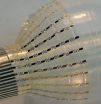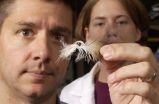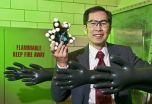(Press-News.org) CHAMPAIGN, Ill. — Cardiologists may soon be able to place sensitive electronics inside their patients' hearts with minimal invasiveness, enabling more sophisticated and efficient diagnosis and treatment of arrhythmias.
A team of materials scientists, mechanical and electrical engineers, and physicians has successfully integrated stretchable electronics technology with standard endocardial balloon catheters. Led by John A. Rogers, the Lee J. Flory-Founder Chair in Engineering at Illinois, the team published its work in the March 6 online edition of Nature Materials.
The team previously demonstrated a sensor-laden sheet that could laminate to the surface of the heart in 2010. Now they have expanded their technology to endocardial balloon catheters, one of the most common, least-invasive devices for cardiac procedures.
Catheters are long, flexible tubes that can be threaded through a vein or artery to reach the inside of the heart. Catheters with balloons at the end are commonly used for angioplasty, stent placement and other procedures as passive mechanical instruments. When in place, the balloon inflates and gently presses against the surrounding tissue to open blood vessels or valves.
Invasive cardiologists specializing in heart rhythm disorders use catheters with electrodes at the end for detecting and mapping arrhythmias and for ablation, or selectively killing small patches of cells that beat off-rhythm. Current invasive arrhythmia procedures involve two separate, rigid catheter devices: one that maps the heart point-by-point as a cardiologist maneuvers the tube in search of irregularities, and one with an electrode at the end that ablates spots identified as aberrant, one at a time.
The balloon device Rogers' team developed can perform both functions over large areas of the heart simultaneously, using integrated arrays of multifunctional sensors and ablation electrodes.
"It's all in one, so it maps and zaps," said Rogers, a professor of materials science and engineering who also is affiliated with the Beckman Institute for Advanced Science and Technology at Illinois. "The idea here is instead of this single-point mapping and separate single-point zapping catheter, have a balloon that offers all that functionality, in a mode that can do spatial mapping in a single step. You just inflate it right into the cavity and softly push all of that electronics and functionality against the tissue."
The researchers created a meshwork of tiny sensor nodes that could mount directly onto a conventional catheter balloon. The device holds an array of sensors to measure electrical activity of the cardiac muscle, temperature, blood flow, and pressure as the balloon presses against the tissue, along with electrodes for ablation. The entire system is designed to operate reliably as the balloon inflates and deflates.
"It demands all the features and capabilities that we've developed in stretchable electronics over the years in a pretty aggressive way," Rogers says. "It also really exercises the technology in an extreme, and useful, manner – we put everything on the soft surface of a rubber balloon and blow it up without any of the devices failing."
The Illinois team collaborated with cardiologists at the University of Arizona and Massachusetts General Hospital (MGH) to determine what types of features would be most useful for patient care.
For example, the researchers added temperature sensors and mapped temperature distribution on actual tissue as areas were ablated. From this data they developed a model to predict temperature distribution so cardiologists know how deep into the tissue they are ablating.
"Adding a feature such as temperature detection and distribution gives us greater insight as to what we are actually doing to the tissue," said co-author Dr. Marvin J. Slepian, a practicing cardiologist and a professor of medicine at the Sarver Heart Center of the University of Arizona. "This will enhance the safety and effectiveness of ablation catheters, providing a new level of precision that we have not had to date, while simultaneously shortening the length of procedure times, which is an overall 'win' for patients, physicians and hospitals."
Rogers' team also worked closely with mc10, a company he co-founded that is commercializing the underlying technology for both medical and non-medical applications. Several researchers at mc10 are co-authors of the paper. The company has tested the devices in live animal experiments with medical collaborators at Arizona and MGH.
The biggest challenge for the researchers was ensuring full functionality of the electronics at all levels of balloon inflation. Since the center of the balloon stretches more than the ends, they had to figure out the range of strain the sensors would encounter and how to accommodate it so that sensors at the most strained points would function the same as those at areas of lower strain.
Through a collaboration with researchers at Northwestern University, led by Younggang Huang, the team solved this problem by mounting the sensors and electrodes on tiny rigid islands so they wouldn't be affected by the balloon stretching. They also used spring-like interconnects between the sensors to handle the 100 percent distance increase between the islands when the balloon inflates.
The fabrication techniques the engineers used in developing the balloon device could be exploited for integrating many classes of advanced semiconductor devices on a variety of surgical instruments. For example, the team also demonstrated surgical gloves with sensor arrays mounted on the fingertips to show that the electronics could be applied to other biomedical platforms.
Next, Rogers would like to further increase the density of sensors on the balloon, up to thousands of tiny, multiplexed devices on the surface. This design would enable the integration of sophisticated electronic systems with the capability for even greater resolution for mapping and the ability to ablate the minimal amount of tissue. He also plans to continue exploring medical device applications for stretchable, flexible electronic arrays in other surgical tools.
"Being able to embed these kinds of advanced semiconductor devices into tissue-like formats creates all kinds of new ways to do minimally invasive procedures," Rogers said. "I'm hopeful that this will be the first of many devices that collectively can have a major impact on the way human health care is done."
INFORMATION:
This work was supported by the National Science Foundation and the Department of Energy. The authors will present related findings at the Heart Rhythm Society Meeting in San Francisco in May.
Editor's note: To contact John A. Rogers, call 217-244-4979; e-mail jrogers@illinois.edu. The paper is available online at http://www.nature.com/nmat/journal/vaop/ncurrent/full/nmat2971.html.
Stretchable balloon electronics get to the heart of cardiac medicine
2011-03-08
ELSE PRESS RELEASES FROM THIS DATE:
New perspective diminishes racial bias in pain treatment
2011-03-08
MADISON — Years of research show black patients getting less treatment in the American health care system than their white counterparts, but a new study suggests that a quick dose of empathy helps close racial gaps in pain treatment.
College students and nurses went to greater lengths to ease the pain of members of their own race in a study led by Brian Drwecki, a psychology graduate student at the University of Wisconsin-Madison.
"I want to be very clear about this: We're not saying health care professionals are racist," Drwecki says. "This is not racism. Racism is ...
DNA better than eyes when counting endangered species
2011-03-08
WEST LAFAYETTE, Ind. - Using genetic methods to count endangered eagles, a group of scientists showed that traditional counting methods can lead to significantly incorrect totals that they believe could adversely affect conservation efforts.
Andrew DeWoody, a professor of genetics at Purdue University; Jamie Ivy, population manager at the San Diego Zoo; and Todd Katzner, a research assistant professor at the University of West Virginia, found that visual counts of imperial and white-tailed sea eagles in the Narzum National Nature Reserve of Kazakhstan significantly underestimated ...
Web use doesn't encourage belief in political rumors, but e-mail does
2011-03-08
COLUMBUS, Ohio – Despite the fears of some, a new study suggests that use of the internet in general does not make people more likely to believe political rumors.
However, one form of internet communication – e-mail – does seem to have troubling consequences for the spread and belief of rumors.
"I think a lot of people will be surprised to learn that using the internet doesn't necessarily promote belief in rumors. Many people seem to think that's self-evident," said R. Kelly Garrett, author of the study and assistant professor of communication at Ohio State University.
"The ...
UCLA researchers use 'nano-Velcro' technology to improve capture of circulating cancer cells
2011-03-08
Circulating tumor cells, which play a crucial role in cancer metastasis, have been known to science for more than 100 years, and researchers have long endeavored to track and capture them. Now, a UCLA research team has developed an innovative device based on Velcro-like nanoscale technology to efficiently identify and "grab" these circulating tumor cells, or CTCs, in the blood.
Metastasis is the most common cause of cancer-related death in patients with solid tumors and occurs when these marauding tumor cells leave the primary tumor site and travel through the blood ...
Story tips from the US Department of Energy's Oak Ridge National Laboratory March 2011
2011-03-08
CYBERSECURITY -- Software agents on assignment . . .
Tracking and protecting information stored on an organization's network could be more secure with a system developed by a team led by Justin Beaver of Oak Ridge National Laboratory's Computational Sciences and Engineering Division. The challenge arises when an organization has documents that are being copied, excerpted, changed and stored in various forms across the organization's network. Host Information Value Engine, dubbed HIVE, solves the problem by dispatching software agents that automatically and quickly review ...
AGU journal highlights -- March 7, 2011
2011-03-08
1. California rapidly depleting Central Valley groundwater
Groundwater is being depleted in California's Central Valley at a rapid rate, according to data from the Gravity Recovery and Climate Experiment (GRACE) satellite. Famiglietti et al. analyze 78 months of GRACE data covering October 2003 to March 2010 to estimate water storage changes in California's Sacramento and San Joaquin River basins. They find that the basins are losing water at a rate of about 30 millimeters (1.2 inches) per year equivalent water height, or a total of about 30 cubic kilometers (7.2 cubic ...
Iowa State, Ames Lab researcher hunts for green catalysts
2011-03-08
AMES, Iowa – L. Keith Woo is searching for cleaner, greener chemical reactions.
Woo, an Iowa State University professor of chemistry and an associate of the U.S. Department of Energy's Ames Laboratory, has studied catalysts and the chemical reactions they affect for more than 25 years. And these days, his focus is on green catalysis.
That, he said, is the search for catalysts that lead to more efficient chemical reactions. That could mean they promote reactions at lower pressures and temperatures. Or it could mean they promote reactions that create less waste. Or it ...
UCLA engineers demonstrate use of proteins as raw material for biofuels, biorefining
2011-03-08
Two types of raw materials are currently used for biorefining and biofuel production: carbohydrates and lipids. Biofuels like ethanol are derived from carbohydrate raw materials such as sugars and lignocellulose, while biodiesels are derived from another raw material, lipid-rich vegetable oil.
In a study published online March 6 in the journal Nature Biotechnology, researchers at the UCLA Henry Samueli School of Engineering and Applied Science demonstrate for the first time the feasibility of using proteins — one of the most abundant biomolecules on earth — as a significant ...
Columbia engineer observes surprising behavior of cells during blood-vessel formation
2011-03-08
Biologists tend to look at cells in bulk, observing them as a group and taking the average behavior as the norm — the assumption is that genetically identical cells all behave the same way. In a paper to be published in the online Early Edition of Proceedings of the National Academy of Sciences the week of March 7, 2011, Sam Sia, assistant professor of biomedical engineering at Columbia Engineering, presents the results of his four-year tissue-engineering study that show a surprising range of variation in how individual cells behave during formation of a blood vessel. Sia ...
Online nutrition courses: Fad or growing trend?
2011-03-08
St. Louis, MO, March 8, 2011 – Most of us have heard of Phoenix, no, not the mystical bird or the capital of Arizona, but the online university. According to the Babson Survey Research Group, enrollment in online courses is growing faster than overall higher education offerings due to various reasons like the economic downturn. With the increase in demand for online education, a study in the March/April 2011 issue of the Journal of Nutrition Education and Behavior explores nine online nutrition courses.
Since nutrition courses meet general education science requirements ...


